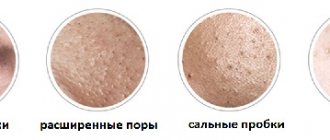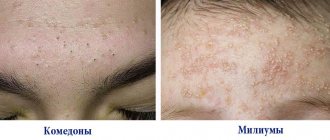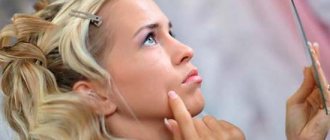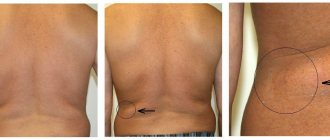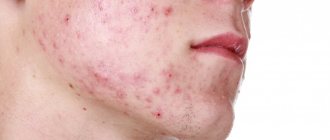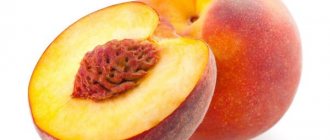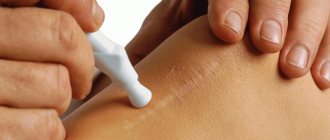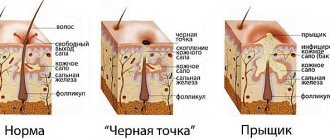What is mesotherapy
The essence of the method is to inject deep into the skin special preparations that smooth out scars. The introduced components have a targeted effect, namely, they improve metabolic processes and regeneration. The best results are achieved when the procedure is performed in the early stages of scarring. Old scars are more difficult to correct, so sometimes mesotherapy is prescribed in combination with other procedures.
Mesotherapy for scars and scars is carried out in cases where the skin has cosmetic defects caused by acne, certain diseases (chickenpox), surgery or trauma. Another advantage of mesotherapy is the rejuvenating effect, which is achieved by smoothing wrinkles and improving skin elasticity.
Laser correction of scars, scars, stretch marks and stretch marks
- No long and grueling rehabilitation.
- 100% safe for health.
- Ease of procedure.
- Affordable price for laser correction of scars after cesarean section, stretch marks due to childbirth, post-traumatic or post-operative scars.
- No prior preparation required.
- Minimum contraindications.
- Use on tanned and pigmented skin.
| TORI Clinic – highly qualified specialists + ultra-modern medical and cosmetology equipment + reasonable price for laser correction of stretch marks in Moscow. The cost of the procedures will definitely suit you, and the end result will exceed your wildest expectations. For details on making an appointment, please call... |
Correction of stretch marks and scars depending on the type
The use of a laser cannot be called a universal way to eliminate stretch marks and scars. Although in many cases it is possible to get by only with laser treatment, there are situations when specialists use additional cosmetic techniques. The correction is selected taking into account the type of scar tissue.
Normotrophic scars
Scars are formed due to the normal healing process of tissue after injury. The color is indistinguishable from healthy skin. Scars do not protrude above the surface and become almost invisible over time. In order to correct such defects, the following 3 methods are used: microdermabrasion, laser resurfacing and superficial chemical peeling.
Atrophic scars
Scars appear due to decreased collagen volume. Lack of protein reduces the elasticity of the skin, the tears of which are replaced by atrophic tissue. A similar thing is observed with post-acne, when indentations remain in place of acne. Stretch marks after pregnancy spoil the skin. To eliminate defects, specialists use laser or highly stabilized hyaluronic acid.
Hypertrophic scars
The reason for the appearance of defects is increased production of collagen in places of damage. Scars protrude above the skin and are usually eliminated by combining several techniques. Firstly, microdermabrasion, that is, mechanical peeling that removes keratinization. Secondly, laser resurfacing. The duration and correction program is determined by a cosmetologist.
Keloid scars
The most difficult defects to correct. There is still debate about the causes of scars in scientific circles. Some experts think that the tendency to form keloid connective tissue formations is inherited. Others believe metabolism plays a key role.
In appearance, scars are similar to tumor growths with a purple or red tint. Defects not only spoil the appearance, but also grow, hurt and cause paresthesia. This type of sensitivity disorder is accompanied by spontaneous burning and tingling in the affected area.
Along with laser, corticosteroid injections or cryogenic therapy are prescribed to eliminate keloid scars. To reduce the size and improve the appearance of damaged areas, botulinum toxin injections are used. The method is relatively new, but has already proven itself well.
Features of the procedure
There are two types of mesotherapy: injection and non-injection, each of which is used in certain situations. Injection mesotherapy of the face and other areas is performed using thin needles or using a special mesoroller. The procedure begins with cleansing the skin, then applying an anesthetic cream. The number of injections depends on the area of the defect and is calculated individually. The non-injection method is performed without puncturing tissue. The active substances are delivered to the cells using ultrasonic waves and low frequency current. The procedure begins with cleaning and disinfecting the skin, after which a pre-selected preparation is applied to the problem area. At the same time, this area of the skin is exposed to ultrasound or another type of wave.
How to remove pits on the face?
There are many ways to get rid of acne marks. Since scars and cicatrices differ from each other, it is important not to try to get rid of them on your own, but to consult a competent cosmetologist or dermatologist. Sometimes, having successfully gotten rid of one type of scar, you can negatively affect another type of scar or pigmentation, so only a specialist should select individual treatment methods.
You can remove craters on your face using:
- Laser polishing.
- Dermabrasion.
- Plastics.
- Acid peelings.
- Fillers and microneedling for atrophic scars.
- Mesotherapy.
To remove large hypertrophic scars, injections of absorbable drugs are used. To do this, corticosteroids, 5-fluorouracil or interferons are injected into the scar tissue.
To completely get rid of a skin defect, several injections of the drug are performed every 1-2 weeks. The result is further consolidated using hardware techniques (resurfacing, microdermabrasion).
Laser resurfacing
One of the most progressive methods of treating post-acne. Allows you to get rid of all types of marks - atrophic and hypertrophic scars, pigmentation, vascular spots. The principle of operation of the method is to evaporate the top layer of skin under the influence of laser flashes.
After the procedure, the regeneration process improves, the formation of new young cells and collagen fibers is stimulated, small facial wrinkles and skin creases are smoothed out.
The procedure is performed under local anesthesia, therefore it is practically painless and has a short recovery period.
After laser resurfacing, it is important to carefully care for your skin and be sure to use a cream with SPF to avoid sunburn and pigmentation.
The disadvantages of laser resurfacing include:
- The procedure can only be performed in specialized salons; local anesthesia is required.
- A long recovery period, which can last up to 3 months for people with sensitive skin.
- Risk of freckles and age spots (with a tendency to hyperpigmentation).
- High cost of the procedure.
When choosing laser resurfacing as a method of treating post-acne, it is important to consider that the procedure is most effective in fair-skinned people. In persons with dark and dark skin, the effect will not be as pronounced.
Z-plasty
In the case of deep atrophic or large keloid scars, if traditional treatment methods are powerless, minor surgery or Z-plasty is performed.
Using a scalpel, the plastic surgeon removes the large scar, leaving behind a small cosmetic scar that can later be treated with resurfacing or chemical peeling.
Microdermabrasion
Delicate mechanical peeling, during which the upper layers of the epidermis are exfoliated using a directed flow of microscopic crystals. The procedure is painless; during it, the client may only feel slight discomfort and tingling.
The duration of the session is on average 30 minutes; to obtain a lasting effect, you will need to carry out 4-6 procedures with an interval of 1-2 weeks. Microdermabrasion can be performed on skin defects of the face, neck, décolleté and other areas of the body.
Advantages:
- The procedure is painless and does not require anesthesia.
- Less traumatic for the skin than other types of dermabrasion.
- Does not require long-term skin restoration and special products for this.
- In addition to post-acne, it copes with pigmentation and fine wrinkles, that is, it has a rejuvenating effect.
However, microcrystalline dermabrasion also has a number of disadvantages that may limit its use:
- It should not be performed on persons with increased individual sensitivity to the components of the product used in the procedure.
- This method is powerless against deep scars and keloid scars.
General contraindications include acute inflammatory processes (ARVI, influenza, pneumonia), oncological pathologies, diabetes mellitus, psoriasis, dermatitis and other skin pathologies in the active phase.
Dermabrasion
Mechanical dermabrasion is a salon facial resurfacing procedure using a special device. The round brush of the device rotates quickly and gently removes the top layer of the epidermis. Using this method, you can eliminate scars and deep scars, get rid of pigmentation and reduce the risk of new spots appearing.
The undeniable advantage of the procedure is its relatively low cost compared to other cosmetic procedures.
The disadvantages of mechanical dermabrasion include:
- Traumatic for the skin.
- Long-term recovery.
- Long course of full face resurfacing.
- Increased skin sensitivity after manipulation.
Like other salon procedures aimed at combating post-acne, dermabrasion has a number of contraindications. It cannot be carried out:
- In the presence of active inflammatory skin diseases, psoriasis, eczema, mycoses.
- During acute infectious pathologies.
- With concomitant diabetes mellitus and oncological pathologies.
It is also not recommended to do mechanical resurfacing of the face during pregnancy and lactation.
Chemical peeling
Under the supervision of a specialist, during the procedure the upper layers of the skin are destroyed using chemicals. The acids included in the peeling destroy intercellular connections, due to which the epidermis layer is “removed”. Damaged and unnecessary cells are removed, and in their place young, smooth skin grows, without scars and age spots.
There are many options for chemical peels:
- Salicylic. Gently exfoliates the upper layer of the epidermis, has an antiseptic effect, tightens pores and regulates sebum production. Used to combat acne and acne marks.
- Jessner peeling. It contains salicylic and lactic acids. This procedure promotes deeper exfoliation of skin cells and stimulates collagen production. Used to combat scars and acne scars.
- Yellow peeling. Superficial, gentle peeling used to combat post-acne. Ideal for removing areas of hyperpigmentation after acne. It has an antioxidant and protective effect thanks to the vitamin A it contains.
In case of pronounced skin changes, a cosmetologist can perform a medium or deep peeling based on trichloroacetic acid or phenol.
Immediately after the procedure, the skin looks reddened and irritated. The next day, peeling begins and continues for several days.
During skin renewal, it is recommended to avoid visiting public swimming pools, baths, and saunas. Before walking outside, you must apply sunscreen. During peeling, you cannot use decorative cosmetics, so experts recommend doing peeling before the weekend in order to wait out the difficult recovery period at home.
How to care for your skin after mesotherapy
After the procedure, the skin needs proper care, which involves following a few simple rules:
- Avoid exposure to ultraviolet and sunlight, use special creams to prevent pigmentation.
- Refuse to use cosmetics.
- Reduce physical activity.
- To refuse from bad habits.
- Limit visits to the sauna, solarium, and swimming pool.
An exact list of recommendations is compiled individually for each patient, taking into account the characteristics of the mesotherapy performed.
Advantages of treatment at the Podology Clinic
- The operations are performed by surgeons who have an academic degree of Candidate of Medical Sciences and the highest qualification category, which confirms the professionalism and experience of doctors.
- Safety during surgical interventions - there is no risk of contracting any infection, since disposable materials are used in the work, and instruments are sterilized according to international standards.
- Individual approach to each patient, selection of methods and methods of treatment, taking into account indications, contraindications, concomitant diseases.
The cost of scar removal depends on the structure and size of the scar, location, method of pain relief and further rehabilitation measures.


